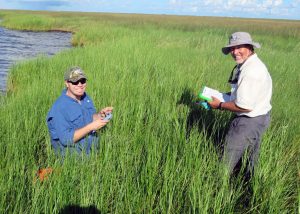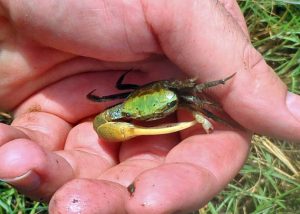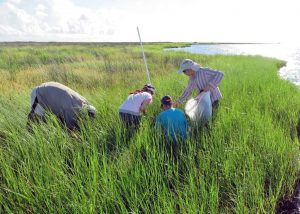Study Investigates Oil Spill Impacts and Recovery of Salt Marsh Fiddler Crab Populations
– JULY 20, 2016
Scientists conducted a meta-analysis of Gulf of Mexico fiddler crab data across multiple years, sites, and studies to examine if the Deepwater Horizon oil spill impacted the crabs’ size, abundance, and population composition.
They found that oiling negatively impacted all three metrics directly following the spill, significantly reducing abundance and size and altering species composition for at least three years. The researchers observed an uneven recovery that was dependent on the recovery of marsh vegetation and sediment. Crab size and species composition recovered over time with abundance recovery lagging. They published their findings in Estuaries and Coasts: Deepwater Horizon Oil Spill Impacts on Salt Marsh Fiddler Crabs (Uca spp.).
Salt marsh fiddler crabs are important components of the marsh ecosystem and food web, but Deepwater Horizon impacts on these crabs have not been well-documented. Their mobile nature makes them difficult to track and associate with a particular area. The team examined research findings related to fiddler crabs from published sources and GoMRI and Natural Resources Damage Assessment (NRDA) datasets. They used fiddler crab burrow density and burrow diameter as proxies for crab abundance and crab size.
Their analysis showed that oiled sites experienced a 39% reduction in crab abundance (borrow density) and a 21 – 44% reduction in crab size (borrow size). Heavily oiled sites exhibited a decrease in crab species that favor densely vegetated marsh areas and an increase in species favoring sparsely vegetated areas. Species composition showed signs of recovery in areas where marsh vegetation cover was restored, suggesting that the fiddler crab species composition would not recover at oiled sites without vegetation recovery. The researchers hypothesize that suppressed fiddler crab populations likely affected other aspects of the marsh ecosystem, including marsh productivity, marsh soil characteristics, and predators that prey on fiddler crabs.
“Salt marsh fiddler crabs are characteristic of and have important influences on the salt marsh ecosystem,” explained study co-author Donald R. Deis, saying that fiddler crabs serve as a good proxy for the health of the benthic marsh ecosystem as a whole. “They both burrow into and feed upon the salt marsh sediment; therefore, oiling of salt marsh sediments impacts the existence of fiddler crabs, making them good indicators of the marsh ecosystem’s recovery.”
The study’s authors are Scott Zengel, Steven C. Pennings, Brian Silliman, Clay Montague, Jennifer Weaver, Donald R. Deis, Michelle O. Krasnec, Nicolle Rutherford, and Zachary Nixon.
GoMRI data are publicly available through the Gulf of Mexico Research Initiative Information and Data Cooperative (GRIIDC) at https://data.gulfresearchinitiative.org/ (doi:10.7266/N7FF3Q9S). Data used in this paper are publically available at https://dwhdiver.orr.noaa.gov/.
************
This research was made possible in part by a grant from the Gulf of Mexico Research Initiative (GoMRI) to the Louisiana State University Department of Oceanography and Coastal Sciences for their projects Accelerating Recovery after the Deepwater Horizon Oil Spill: Response of the Plant-Microbial-Benthic Ecosystem to Mitigation Strategies Promoting Wetland Remediation and Resilience and Long-Term Impact, Recovery and Resilience: Wetland Plant-Microbial-Benthic Ecosystem Responses to the Deepwater Horizon Oil Spill and Mitigation Strategies Promoting Sustainability and to the Florida Institute of Oceanography (FIO). Other funding sources include the National Oceanic and Atmospheric Administration (NOAA), the State of Louisiana, and the National Science Foundation.
The Gulf of Mexico Research Initiative (GoMRI) is a 10-year independent research program established to study the effect, and the potential associated impact, of hydrocarbon releases on the environment and public health, as well as to develop improved spill mitigation, oil detection, characterization and remediation technologies. An independent and academic 20-member Research Board makes the funding and research direction decisions to ensure the intellectual quality, effectiveness and academic independence of the GoMRI research. All research data, findings and publications will be made publicly available. The program was established through a $500 million financial commitment from BP. For more information, visit https://gulfresearchinitiative.org/.
© Copyright 2010- 2017 Gulf of Mexico Research Initiative (GoMRI) – All Rights Reserved. Redistribution is encouraged with acknowledgement to the Gulf of Mexico Research Initiative (GoMRI). Please credit images and/or videos as done in each article. Questions? Contact web-content editor Nilde “Maggie” Dannreuther, Northern Gulf Institute, Mississippi State University (maggied@ngi.msstate.edu).








